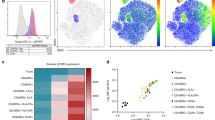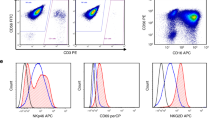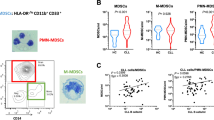Abstract
To date, myeloid-derived suppressor cells (MDSC) have been best studied in cancer, where they represent an escape mechanism for immune surveillance. MDSC are now also gaining interest in the context of transplantation. Suppressive CD11b+ myeloid progenitor cells have been reported to expand endogenously during BM chimerism induction in mice; in particular, in irradiated MHC-matched BM chimeras and in parent-in-F1 BM chimeras. Myeloid cell expansion coincided with a time frame where donor lymphocyte infusion (DLI) therapy-mediated GVL effects without GVHD. Hypothesizing that regulatory myeloid cells may have a role in regulating post-transplant T-cell alloreactivity, we performed a detailed phenotypic and functional characterization of these cells in the parent-in-F1 C57BL/6 → [C57BL/6xDBA2] model. We found that transiently expanding CD11b+ myeloid progenitor cells comprise the two phenotypically and functionally distinct mononuclear and polymorphonuclear MDSC subsets that were recently described in tumor-bearing mice. Both MDSC subsets suppressed in vitro and in vivo alloreactive T-cell proliferation. Also, both the subsets mediated enhanced in vitro suppression when harvested from chimeras, given a prior in vivo challenge with non-tolerant donor T cells, indicating that allo-activated T cells can activate MDSC in vivo. This study provides the basis to investigate the—potentially beneficial—role of expanding MDSC in influencing the risk of GVHD during chimerism induction.
This is a preview of subscription content, access via your institution
Access options
Subscribe to this journal
Receive 12 print issues and online access
$259.00 per year
only $21.58 per issue
Buy this article
- Purchase on Springer Link
- Instant access to full article PDF
Prices may be subject to local taxes which are calculated during checkout




Similar content being viewed by others
References
Young MR, Lathers DM . Myeloid progenitor cells mediate immune suppression in patients with head and neck cancers. Int J Immunopharmacol 1999; 21: 241–252.
Bronte V, Apolloni E, Cabrelle A, Ronca R, Serafini P, Zamboni P et al. Identification of a CD11b(+)/Gr-1(+)/CD31(+) myeloid progenitor capable of activating or suppressing CD8(+) T cells. Blood 2000; 96: 3838–3846.
Delano MJ, Scumpia PO, Weinstein JS, Coco D, Nagaraj S, Kelly-Scumpia KM et al. MyD88-dependent expansion of an immature GR-1(+)CD11b(+) population induces T cell suppression and Th2 polarization in sepsis. J Exp Med 2007; 204: 1463–1474.
Haile LA, von WR, Gamrekelashvili J, Kruger C, Bachmann O, Westendorf AM et al. Myeloid-derived suppressor cells in inflammatory bowel disease: a new immunoregulatory pathway. Gastroenterology 2008; 135: 871–881.
Zhu B, Bando Y, Xiao S, Yang K, Anderson AC, Kuchroo VK et al. CD11b+Ly-6C(hi) suppressive monocytes in experimental autoimmune encephalomyelitis. J Immunol 2007; 179: 5228–5237.
Gabrilovich DI, Bronte V, Chen SH, Colombo MP, Ochoa A, Ostrand-Rosenberg S et al. The terminology issue for myeloid-derived suppressor cells. Cancer Res 2007; 67: 425.
Diaz-Montero CM, Salem ML, Nishimura MI, Garrett-Mayer E, Cole DJ, Montero AJ . Increased circulating myeloid-derived suppressor cells correlate with clinical cancer stage, metastatic tumor burden, and doxorubicin-cyclophosphamide chemotherapy. Cancer Immunol Immunother 2009; 58: 49–59.
Zea AH, Rodriguez PC, Atkins MB, Hernandez C, Signoretti S, Zabaleta J et al. Arginase-producing myeloid suppressor cells in renal cell carcinoma patients: a mechanism of tumor evasion. Cancer Res 2005; 65: 3044–3048.
Filipazzi P, Valenti R, Huber V, Pilla L, Canese P, Iero M et al. Identification of a new subset of myeloid suppressor cells in peripheral blood of melanoma patients with modulation by a granulocyte-macrophage colony-stimulation factor-based antitumor vaccine. J Clin Oncol 2007; 25: 2546–2553.
Marigo I, Dolcetti L, Serafini P, Zanovello P, Bronte V . Tumor-induced tolerance and immune suppression by myeloid derived suppressor cells. Immunol Rev 2008; 222: 162–179.
Movahedi K, Guilliams M, Van den Bossche J, Van den Bergh R, Gysemans C, Beschin A et al. Identification of discrete tumor-induced myeloid-derived suppressor cell subpopulations with distinct T cell-suppressive activity. Blood 2008; 111: 4233–4244.
Peranzoni E, Zilio S, Marigo I, Dolcetti L, Zanovello P, Mandruzzato S et al. Myeloid-derived suppressor cell heterogeneity and subset definition. Curr Opin Immunol 2010; 22: 238–244.
Mandruzzato S, Solito S, Falisi E, Francescato S, Chiarion-Sileni V, Mocellin S et al. IL4Ralpha+ myeloid-derived suppressor cell expansion in cancer patients. J Immunol 2009; 182: 6562–6568.
Morecki S, Gelfand Y, Yacovlev E, Eizik O, Shabat Y, Slavin S . CpG-induced myeloid CD11b+Gr-1+ cells efficiently suppress T cell-mediated immunoreactivity and graft-versus-host disease in a murine model of allogeneic cell therapy. Biol Blood Marrow Transplant 2008; 14: 973–984.
De Wilde V, Van Rompaey N, Hill M, Lebrun JF, Lemaitre P, Lhomme F et al. Endotoxin-induced myeloid-derived suppressor cells inhibit alloimmune responses via heme oxygenase-1. Am J Transplant 2009; 9: 2034–2047.
Zhou Z, French DL, Ma G, Eisenstein S, Chen Y, Divino CM et al. Development and function of myeloid-derived suppressor cells generated from mouse embryonic and hematopoietic stem cells. Stem Cells 2010; 28: 620–632.
Highfill SL, Rodriguez PC, Zhou Q, Goetz CA, Koehn BH, Veenstra R et al. Bone marrow myeloid-derived suppressor cells (MDSC) inhibit graft-versus-host (GVHD) disease via an arginase-1 dependent mechanism that is upregulated by IL-13. Blood 2010; 116: 5738–5747.
Billiau AD, Fevery S, Rutgeerts O, Landuyt W, Waer M . Transient expansion of Mac1+Ly6-G+Ly6-C+ early myeloid cells with suppressor activity in spleens of murine radiation marrow chimeras: possible implications for the graft-versus-host and graft-versus-leukemia reactivity of donor lymphocyte infusions. Blood 2003; 102: 740–748.
Sprangers B, Van Wijmeersch B, Luyckx A, Sagaert X, Verbinnen B, Rutgeerts O et al. Subclinical GvHD in non-irradiated F1 hybrids: severe lymphoid-tissue GvHD causing prolonged immune dysfunction. Bone Marrow Transplant 2010; 46: 586–596.
Appelbaum FR . The current status of hematopoietic cell transplantation. Annu Rev Med 2003; 54: 491–512.
Huff CA, Fuchs EJ, Smith BD, Blackford A, Garrett-Mayer E, Brodsky RA et al. Graft-versus-host reactions and the effectiveness of donor lymphocyte infusions. Biol Blood Marrow Transplant 2006; 12: 414–421.
Luyckx A, De Somer L, Rutgeerts O, Waer M, Verfaillie CM, Van GS et al. Mouse MAPC-mediated immunomodulation: cell-line dependent variation. Exp Hematol 2010; 38: 1–2.
Luyckx A, De Somer L, Jacobs S, Rutgeerts O, Lenaerts C, Roobrouck VD et al. Oct4-negative multipotent adult progenitor cells and mesenchymal stem cells as regulators of T-cell alloreactivity in mice. Immunol Lett 2011; 137: 78–81.
Sefrioui H, Billiau AD, Waer M . Graft-versus-leukemia effect in minor antigen mismatched chimeras given delayed donor leucocyte infusion: immunoregulatory aspects and role of donor T and ASGM1-positive cells. Transplantation 2000; 70: 348–353.
Billiau AD, Fevery S, Rutgeerts O, Landuyt W, Waer M . Crucial role of timing of donor lymphocyte infusion in generating dissociated graft-versus-host and graft-versus-leukemia responses in mice receiving allogeneic bone marrow transplants. Blood 2002; 100: 1894–1902.
Sprangers B, Van Wijmeersch B, Fevery S, Waer M, Billiau AD . Experimental and clinical approaches for optimization of the graft-versus-leukemia effect. Nat Clin Pract Oncol 2007; 4: 404–414.
Bloom ML, Wolk AG, Simon-Stoos KL, Bard JS, Chen J, Young NS . A mouse model of lymphocyte infusion-induced bone marrow failure. Exp Hematol 2004; 32: 1163–1172.
Billiau AD, Sefrioui H, Overbergh L, Rutgeerts O, Goebels J, Mathieu C et al. Transforming growth factor-beta inhibits lymphokine activated killer cytotoxicity of bone marrow cells: implications for the graft-versus-leukemia effect in irradiation allogeneic bone marrow chimeras. Transplantation 2001; 71: 292–299.
Chakraverty R, Cote D, Buchli J, Cotter P, Hsu R, Zhao G et al. An inflammatory checkpoint regulates recruitment of graft-versus-host reactive T cells to peripheral tissues. J Exp Med 2006; 203: 2021–2031.
Mapara MY, Kim YM, Wang SP, Bronson R, Sachs DH, Sykes M . Donor lymphocyte infusions mediate superior graft-versus-leukemia effects in mixed compared to fully allogeneic chimeras: a critical role for host antigen-presenting cells. Blood 2002; 100: 1903–1909.
Joo YD, Lee SM, Lee SW, Lee WS, Lee SM, Park JK et al. Granulocyte colony-stimulating factor-induced immature myeloid cells inhibit acute graft-versus-host disease lethality through an indoleamine dioxygenase-independent mechanism. Immunology 2009; 128 (Suppl): e632–e640.
MacDonald KP, Rowe V, Clouston AD, Welply JK, Kuns RD, Ferrara JL et al. Cytokine expanded myeloid precursors function as regulatory antigen-presenting cells and promote tolerance through IL-10-producing regulatory T cells. J Immunol 2005; 174: 1841–1850.
Nausch N, Galani IE, Schlecker E, Cerwenka A . Mononuclear myeloid-derived ‘suppressor’ cells express RAE-1 and activate natural killer cells. Blood 2008; 112: 4080–4089.
Bronte V, Serafini P, Mazzoni A, Segal DM, Zanovello P . L-arginine metabolism in myeloid cells controls T-lymphocyte functions. Trends Immunol 2003; 24: 302–306.
Storek J, Geddes M, Khan F, Huard B, Helg C, Chalandon Y et al. Reconstitution of the immune system after hematopoietic stem cell transplantation in humans. Semin Immunopathol 2008; 30: 425–437.
Korbling M, Anderlini P . Peripheral blood stem cell versus bone marrow allotransplantation: does the source of hematopoietic stem cells matter? Blood 2001; 98: 2900–2908.
Mielcarek M, Martin PJ, Torok-Storb B . Suppression of alloantigen-induced T-cell proliferation by CD14+ cells derived from granulocyte colony-stimulating factor-mobilized peripheral blood mononuclear cells. Blood 1997; 89: 1629–1634.
Vasconcelos ZF, Santos BM, Costa ES, Lima M, Tabak DG, Bouzas LF et al. T-lymphocyte function from peripheral blood stem-cell donors is inhibited by activated granulocytes. Cytotherapy 2003; 5: 336–345.
Acknowledgements
We acknowledge Martijn Baeten and Camillle Mommer for their technical support. This work was supported by a grant of the Institute for the Promotion of Innovation by Science and Technology in Flanders and the Flanders National Fund for Scientific Research.
Author contributions: ADB, MW conceived the study. ADB, AL, JAVG and ES designed the experiments. AL, ES performed the experiments. OR, CL, SF and CK provided technical assistance. AL, ES, ADB and JAVG analyzed the results. AL and ADB wrote the paper, with critical revision by SF, JAVG, MW, TD and DD.
Author information
Authors and Affiliations
Corresponding author
Ethics declarations
Competing interests
The authors declare no conflict of interest.
Rights and permissions
About this article
Cite this article
Luyckx, A., Schouppe, E., Rutgeerts, O. et al. Subset characterization of myeloid-derived suppressor cells arising during induction of BM chimerism in mice. Bone Marrow Transplant 47, 985–992 (2012). https://doi.org/10.1038/bmt.2011.207
Received:
Accepted:
Published:
Issue Date:
DOI: https://doi.org/10.1038/bmt.2011.207
Keywords
This article is cited by
-
Myeloid-derived suppressor cells in transplantation: the dawn of cell therapy
Journal of Translational Medicine (2018)
-
Reduction of myeloid-derived suppressor cells reinforces the anti-solid tumor effect of recipient leukocyte infusion in murine neuroblastoma-bearing allogeneic bone marrow chimeras
Cancer Immunology, Immunotherapy (2018)
-
The impact of circulating suppressor cells in multiple myeloma patients on clinical outcome of DLIs
Bone Marrow Transplantation (2015)
-
Non-traditional CD4+CD25−CD69+ regulatory T cells are correlated to leukemia relapse after allogeneic hematopoietic stem cell transplantation
Journal of Translational Medicine (2014)
-
Immunosuppressive CD14+HLA-DRlow/neg IDO+ myeloid cells in patients following allogeneic hematopoietic stem cell transplantation
Leukemia (2013)



